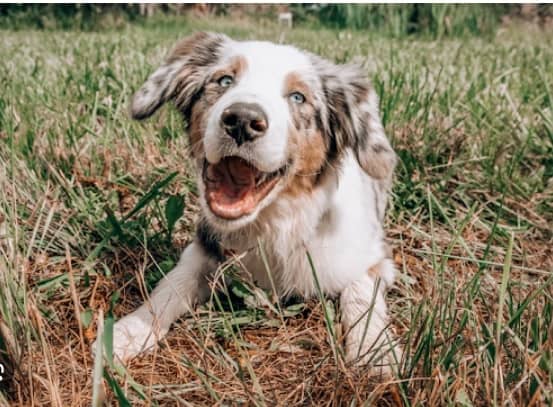Do you ever wonder what your pup is thinking? You’re not alone! Understanding a dog’s body language is key to healthy relationships with your pet.
But how do you read their cues correctly? Don’t worry – it’s easier than you think! With just a few simple observations, you can learn to interpret the subtle movements of your canine companion.
You can better understand their emotions and respond appropriately by studying how dogs communicate through their ears, facial expressions, and body language.
So let’s look at the basics of dog body language and discover how to read your pup’s non-verbal signals!
Basics of Dog Body Language
Understanding a dog’s body language, including how they lay down, is key to interpreting their emotions and building a strong bond. So, get ready to start deciphering those tail wags, nose nudges, and the way your dog lays on top! By understanding canine behavior, you can better connect with your dog and socialize them in the right way. This knowledge will help you strengthen your bond, improve communication, and create a harmonious relationship with your furry friend.

You can tell precisely when dogs feel anxious or excited by learning how dogs communicate nonverbally. When observing your pup’s body language, the eyes are often the most spoken part. Dogs who feel uncomfortable will narrow their eyes slightly and avert their gaze, whereas contented dogs will have relaxed facial features and maintain eye contact with you.
If your pup has dilated pupils, it usually indicates that they feel scared or threatened. It’s also important to pay attention to other signs of communication, like barks, growls, and whines, as these can all indicate different emotions depending on their pitch and volume. And, of course, remember those tail wags – while sometimes they do mean excitement or joy, more often than not, they signify insecurity or confusion about what is happening around them.
By recognizing these subtle signs of emotion in your dog’s body language, you can ensure that both of you remain safe and happy together!
How Dogs Communicate Through Their Bodies
You can read your pup’s emotions like a book by observing their body movements – from the tilt of their head to the wag of their tail. Dogs are master communicators and rely heavily on nonverbal cues for communication.
Here’s how you can learn to recognize some key signs that may indicate how your pup is feeling:
- Reading Tail Wags: A relaxed wagging tail indicates happiness, while a stiffer wag or rapid movement may mean they’re feeling anxious or threatened.
- Recognizing Barks: Dogs bark for various reasons – they may bark when they’re excited, scared, frustrated, or even trying to alert you to something in the environment. Paying attention to the pitch and intensity of their barks is essential for understanding their communication. At Barking Hound Village, we believe in creating the best place for dogs, where their needs are met and their voices are heard. By learning to decipher your furry companion’s barks, you can respond appropriately and provide them with the care and attention they deserve.
- Body Posture: If your pup stands tall with ears perked up and forward, it usually means they’re curious and ready for action! On the other hand, if they drop into a crouch position with their ears flat against their head and eyes wide open, this could be a sign that they’re scared or uncertain.
Understanding these subtle differences can help give you insight into how your pup feels at any given moment so that you can adjust accordingly!
By learning the basics of dog body language, you’ll gain invaluable insight into your pup’s wants and needs – allowing you to create an even deeper bond!
How Dogs Communicate Through Their Ears
By tuning into your pup’s ears, you can pick up on their subtle cues and better grasp how they’re feeling – deepening your connection with them in the process! When analyzing your dog’s body language, paying attention to their ear position is essential. They may move their ears back and forth or hold them at attention if they show signs of alertness. Additionally, when dogs are relaxed or content, they often lay their ears back flat against their head. To help better understand how dogs communicate through their ears, here is a table that outlines different types of ear movements and what each one means:
| Ear Movement | Meaning |
|---|---|
| Ears Perked Up | Alert/Interest/Excitement |
| Ears Pointed Forward | Interest/Ready for Action |
| Ears Tilted Backwards | Relaxed/Calm/Submissive (usually accompanied by tail signals and vocal cues) |
| Ears Flattened Against Head | Fearful/Anxious/Insecure (usually accompanied by tail signals and vocal cues) |
It is also important to note that some breeds of dogs have naturally floppy or erect ears, which may change the meaning of certain ear positions slightly. For example, a breed such as Cocker Spaniels tends to have semi-erect ears, which may be more difficult to interpret than other breeds with erect or floppy ears. However, with enough practice and observation, you should be able to easily understand what your pup is communicating through its body language. With this newfound knowledge comes a greater understanding of our beloved pet companions – allowing us to build trust between us both!
How Dogs Communicate Through Their Facial Expressions
By observing your pup’s facial expressions, you can gain insight into their feelings and strengthen the bond with them. Paying attention to these small indicators can help you understand exactly what your puppy is trying to say:
- A relaxed face with a slightly open mouth suggests contentment.
- Whiskers that are pulled back indicate curiosity or alertness.
- A raised brow conveys surprise or confusion.
- Soft eyes show affection and trustworthiness.
And a tail wagging, combined with direct eye contact, shows excitement and joy!
Understanding how our four-legged friends communicate using their faces is integral to forming a strong connection between humans and dogs. With practice, it’ll become easier for you to recognize subtle changes in facial expressions – allowing you to read the emotions of your pup more accurately than ever before!
Your pup’s body language won’t be a mystery anymore – instead, it’ll provide insight into how they feel so that you can give them the love and attention they need when needed most!
Interpreting Emotions in Dogs
Interpreting the subtle nuances of canine emotion can be an invaluable way to deepen your bond with your furry companion and interpret their needs more accurately. To do this, it’s essential to understand how dogs communicate their emotions through body language.
Dog behavior can be broken down into several components: facial expressions, tail wagging, posture, and vocalizations. Each of these behaviors has a distinct purpose and helps you gain insight into your dog’s feelings at any moment.
Facial expressions are dogs’ most obvious ways to communicate their emotional state. A relaxed face often means they’re content, while narrowed eyes may indicate anger or fear. The ears also play an essential role in conveying emotion—ears that are perked up often show excitement or curiosity. In contrast, drooping ears can signal lower levels of energy or relaxation.
Tail wagging is another standard behavioral indicator for determining dog moods—a wide-sweeping tail movement usually shows happiness or excitement. At the same time, a slow wag may mean confusion or anxiety. Additionally, the direction of the tail wag can provide further insight into your pup’s feelings; if it’s pointing towards something specific, they likely have strong emotions about it!
Posture and vocalizations such as barking and growling should also be noticed when interpreting canine emotion. A low stance with a tail tucked between the legs could signal submission or fearfulness, whereas a high viewpoint with forward-facing ears could mean aggression. All of these signs should be taken together to better understand what your pet feels at any given time.
SEE ALSO:
Welcome to Puppy Haven – Where Puppy Dreams Come True
Dog Night Vision: Unveiling Canine Visual Adaptations
Train Your Dog To Be Safe With Kids
Frequently Asked Questions
How can I tell if my dog is feeling anxious or fearful?
When understanding your dog’s emotions, you must watch their body language. You’ll need to be an expert in canine communication, but learning the basics of what is known as calming signals can get you up and running quickly.
For example, if your pup is anxious or fearful, they may show signs such as licking their lips, yawning, turning away from stimuli that scare them, or even freezing in place. All these behaviors indicate distress and should not be ignored.
Recognizing these signs can help provide comfort and reassurance for your pup when they need it most – a true sign of a loving pet owner!
How do I know if my dog is happy to see me?
It’s easy to tell when your dog is happy to see you. They may jump up and down, bark excitedly, or wag their tail rapidly.
Positive reinforcement through playtime interaction is a great way to show them love – give them treats or take them out for a walk and watch as they become even more enthusiastic in front of you.
So if your pup greets you with excitement, it’s likely that they’re pleased to have you around!
How can I get my dog to understand me better?
You can get your dog to understand you better through positive reinforcement and social interaction.
Imagine a world where you reward your pup with treats or petting for good behavior, and spend time playing together when they act how you want them to.
With this approach, your puppy will quickly learn what behaviors are expected of them and will come to understand the commands you give them more readily.
Positive reinforcement techniques have been proven to be very effective at teaching dogs how to behave, so make sure to use them whenever possible!
What is the best way to read my dog’s body language?
Knowing how to read your dog’s body language is critical to understanding them and strengthening your relationship.
A few important things to look for include their tail position, ears, eyes, and mouth. They’re likely happy or excited when their tail is up and wagging.
If their ears are pulled back, they may be scared or anxious. Also, look at the shape of their eyes – when wide open with a relaxed face, it usually means they feel safe.
And finally, pay attention to their mouth; if it’s closed with a relaxed jaw, they are likely content.
Positive reinforcement can also help them learn how you would like them to act in certain situations, as well as get them plenty of exercises so that they stay healthy and calm in any case.
How can I tell if my dog is feeling aggressive?
Learning how to read your dog’s body language can be key in understanding if they’re feeling aggressive.
Signs of aggression may include growling, showing teeth, raised hackles, and a stiff posture.
Socialize with other dogs and people early on to help prevent your dog from feeling aggressive.
Additionally, provide plenty of positive reinforcement when they display good behavior so that they associate their actions with reward rather than punishment.
With these tips, you can better understand your pup’s feelings and keep them safe from harm!
Conclusion
You now know the basics of interpreting your pup’s body language. You can easily decipher your dog’s feelings, from their ears to facial expressions.
Remember, dogs are just as emotional as humans and can feel many emotions, including joy, fear, aggression, and more.
It’s estimated that dogs understand human language in up to 250 words! That’s impressive for our four-legged friends.
The next time you interact with your pup, take some time to observe them and see what they’re trying to tell you – it’ll be worth it in the end!
“Join the Journey to Save Lives! Support Bone Voyage Dog Rescue Today!”


